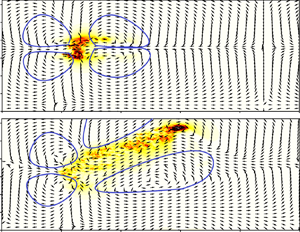Article contents
Minimal energy thresholds for sustained turbulent bands in channel flow
Published online by Cambridge University Press: 18 May 2022
Abstract

In this work, nonlinear variational optimization is used for obtaining minimal seeds for the formation of turbulent bands in channel flow. Using nonlinear optimization together with energy bisection, we have found that the minimal energy threshold for obtaining spatially patterned turbulence scales with  $Re^{-8.5}$ for
$Re^{-8.5}$ for  $Re>1000$. The minimal seed, which is different to that found in a much smaller domain, is characterized by a spot-like structure surrounded by a low-amplitude large-scale quadrupolar flow filling the whole domain. This minimal-energy perturbation of the laminar flow has dominant wavelengths close to
$Re>1000$. The minimal seed, which is different to that found in a much smaller domain, is characterized by a spot-like structure surrounded by a low-amplitude large-scale quadrupolar flow filling the whole domain. This minimal-energy perturbation of the laminar flow has dominant wavelengths close to  $4$ in the streamwise direction and
$4$ in the streamwise direction and  $1$ in the spanwise direction, and is characterized by a spatial localization increasing with the Reynolds number. At
$1$ in the spanwise direction, and is characterized by a spatial localization increasing with the Reynolds number. At  $Re \lesssim 1200$, the minimal seed evolves in time, creating an isolated oblique band, whereas for
$Re \lesssim 1200$, the minimal seed evolves in time, creating an isolated oblique band, whereas for  $Re\gtrsim 1200$, a quasi-spanwise-symmetric evolution is observed, giving rise to two distinct bands. A similar evolution is found also at low
$Re\gtrsim 1200$, a quasi-spanwise-symmetric evolution is observed, giving rise to two distinct bands. A similar evolution is found also at low  $Re$ for non-minimal optimal perturbations. This highlights two different mechanisms of formation of turbulent bands in channel flow, depending on the Reynolds number and initial energy of the perturbation. The selection of one of these two mechanisms appears to be dependent on the probability of decay of the newly created stripe, which increases with time, but decreases with the Reynolds number.
$Re$ for non-minimal optimal perturbations. This highlights two different mechanisms of formation of turbulent bands in channel flow, depending on the Reynolds number and initial energy of the perturbation. The selection of one of these two mechanisms appears to be dependent on the probability of decay of the newly created stripe, which increases with time, but decreases with the Reynolds number.
- Type
- JFM Papers
- Information
- Copyright
- © The Author(s), 2022. Published by Cambridge University Press
References
REFERENCES
- 2
- Cited by





